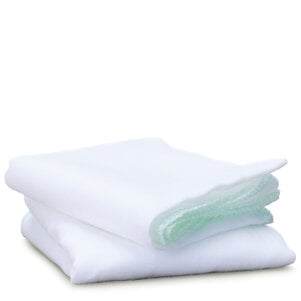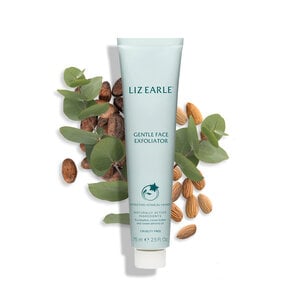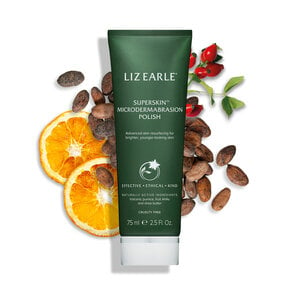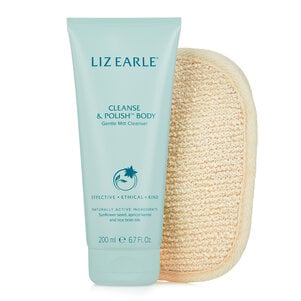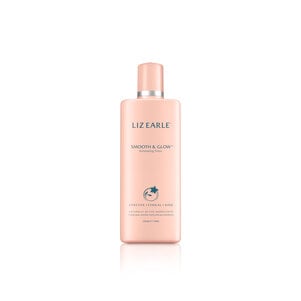
How to Exfoliate the Right Way
April 26, 2024
3 min read
Our skin goes through a constant cycle. Around every 30 days, we naturally shed dead skin cells from the top layer of our skin to allow new cells to form. Exfoliators are products or tools that help clean these dead skin cells away, making room for a brighter and more radiant-looking complexion.
So, what are the benefits of exfoliating, and what’s the best exfoliator to use for your skin type? Here’s our helpful guide to exfoliating the right way.
Why should I exfoliate?
As we age, the speed of our cells turning over (shedding dead cells to produce new ones) begins to slow down. If these dead cells are left on the surface, they can begin to cause a duller complexion and over time can block your pores. This can then lead to breakouts of acne or oily skin.But what do exfoliators do? When you use a face exfoliator or exfoliating scrub, you’re able to effectively sweep away the layer of dead skin and restore a brighter, more radiant complexion underneath. Not only this, but you’ll also be removing any build-up of dirt, oil and other impurities that can accumulate on your skin throughout the day. This all helps prevent pore-clogging, which can lead to the appearance of blemishes, blackheads, and whiteheads, for clearer-looking skin.
Another reason it’s a good idea to exfoliate your face and body is that this process of removing dead skin cells also helps encourage cell turnover, which helps even out the skin tone and helps remove any areas of ‘damage’ – for example, things like the appearance of uneven skin texture and pigmentation may begin to fade more quickly.
Making way for the healthier-looking skin underneath and bringing it to the surface means your skincare products are more likely to fully absorb into the skin. Plus make up application might become smoother, too.


How do I exfoliate?
So, what should you use to exfoliate the face? The most important thing is to find a method that works for your skin’s needs, as some methods are more suited to specific skin types.First, let’s talk about the different ways you can exfoliate your skin. There are two main categories of exfoliators – mechanical exfoliators and chemical exfoliators. A mechanical method includes products like face scrubs that contain gentle exfoliating ingredients, like pumice or jojoba beads, or a tool like a brush or sponge that work to physically get dead skin cells off your face. A chemical exfoliator is a product that contains alpha hydroxy acids (AHAs) or beta hydroxy acids (BHAs) that, when applied to the face, will gently dissolve the dead skin cells and impurities.
Most people with a dry, sensitive or blemish-prone skin type find that using a washcloth with a mild chemical exfoliator is the best method for them. This is because mechanical methods or ingredients can sometimes be too irritating for dry skin or sensitive skin. Once the product is on the cloth, apply it gently to the skin using small, circular motions.
To exfoliate oily skin, a stronger chemical exfoliator or a mechanical exfoliator works best. When using a physical face scrub or an exfoliating cleanser for face, it’s important to remember to be gentle, working slowly in circles for around 30 seconds before rinsing with lukewarm water. Our Gentle Face Exfoliator uses jojoba beads to gently buff away impurities, while our Superskin™ Microdermabrasion Polish combines both fruit AHAs and volcanic pumice to help instantly brighten and smooth while supporting surface skin cell renewal.
If you’d prefer to use a mitt, sponge or tool to exfoliate, use short, light strokes. Exfoliation with a mitt or tool is more suited to your body than face, due to the skin on your face and neck being more fragile than the skin on the rest of your body. For exfoliated and more radiant skin on your body, try our Cleanse & Polish™ Body Gentle Mitt Cleanser.
As well as your skin type, it’s also important to consider the other products you use as part of your daily routine. Some medications or over the counter products can cause skin to become more sensitive or to ‘peel’ – for example, prescription-strength retinoids. Using an exfoliator alongside these could cause dry skin to feel more dehydrated or cause breakouts. You should also never exfoliate skin that is damaged, such as an open cut or wound, or if you’re sunburnt.
Once you’ve finished exfoliating, follow up with your usual serums and make sure to apply a good amount of moisturiser to keep skin feeling soft, supple and hydrated.


How often should I exfoliate?
It’s best to start slowly with an exfoliator – this is because your skin may not be used to certain ingredients and you want to minimise any risk of damaging your skin or it’s natural barrier.If you’re using a chemical exfoliator, you should only use this twice a week, as some AHAs or BHAs can be irritating to the skin if used too much. However, there are some chemical exfoliators which are formulated to be gentle enough to use daily, like our Smooth & Glow™ Exfoliating Tonic. It’s powered by prickly pear (nature’s powerful brightening exfoliant), acerola cherry and sea buckthorn.
While mechanical exfoliators might not include any acids, it’s still best to aim for once or twice a week. If you’re exfoliating your body, begin with once a week and slowly work up to every few days or every other day if you feel you need it. Exfoliating your body helps remove any surface dirt, grime and dead skin cells, and helps your body feel softer and more refreshed.
You’ll soon find the right schedule for you – just listen to your skin and stop using a product if you notice any redness, peeling or flaking. These are all visible signs that you might be overdoing it. As long as you follow the instructions of the product you’re using and stick to a gentle exfoliating technique, you’ll soon have a healthy-feeling, radiant-looking complexion.
SHOP THE PRODUCTS
